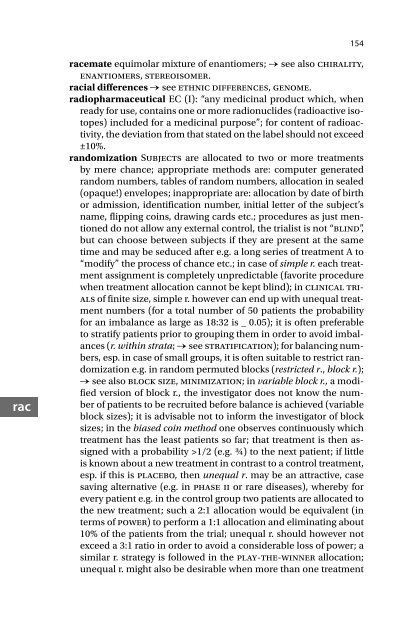220-Dictionary of Pharmaceutical Medicine, 2nd Edition-Gerhard Nahler Annette Mollet-3211898352-S
220-Dictionary of Pharmaceutical Medicine, 2nd Edition-Gerhard Nahler Annette Mollet-3211898352-S
220-Dictionary of Pharmaceutical Medicine, 2nd Edition-Gerhard Nahler Annette Mollet-3211898352-S
Create successful ePaper yourself
Turn your PDF publications into a flip-book with our unique Google optimized e-Paper software.
154racracemate equimolar mixture <strong>of</strong> enantiomers; → see also chirality,enantiomers, stereoisomer.racial differences → see ethnic differences, genome.radiopharmaceutical EC (I): “any medicinal product which, whenready for use, contains one or more radionuclides (radioactive isotopes)included for a medicinal purpose”; for content <strong>of</strong> radioactivity,the deviation from that stated on the label should not exceed±10%.randomization Subjects are allocated to two or more treatmentsby mere chance; appropriate methods are: computer generatedrandom numbers, tables <strong>of</strong> random numbers, allocation in sealed(opaque!) envelopes; inappropriate are: allocation by date <strong>of</strong> birthor admission, identification number, initial letter <strong>of</strong> the subject’sname, flipping coins, drawing cards etc.; procedures as just mentioneddo not allow any external control, the trialist is not “blind”,but can choose between subjects if they are present at the sametime and may be seduced after e.g. a long series <strong>of</strong> treatment A to“modify” the process <strong>of</strong> chance etc.; in case <strong>of</strong> simple r. each treatmentassignment is completely unpredictable (favorite procedurewhen treatment allocation cannot be kept blind); in clinical trials<strong>of</strong> finite size, simple r. however can end up with unequal treatmentnumbers (for a total number <strong>of</strong> 50 patients the probabilityfor an imbalance as large as 18:32 is _ 0.05); it is <strong>of</strong>ten preferableto stratify patients prior to grouping them in order to avoid imbalances(r. within strata; → see stratification); for balancing numbers,esp. in case <strong>of</strong> small groups, it is <strong>of</strong>ten suitable to restrict randomizatione.g. in random permuted blocks (restricted r., block r.);→ see also block size, minimization; in variable block r., a modifiedversion <strong>of</strong> block r., the investigator does not know the number<strong>of</strong> patients to be recruited before balance is achieved (variableblock sizes); it is advisable not to inform the investigator <strong>of</strong> blocksizes; in the biased coin method one observes continuously whichtreatment has the least patients so far; that treatment is then assignedwith a probability >1/2 (e.g. ¾) to the next patient; if littleis known about a new treatment in contrast to a control treatment,esp. if this is placebo, then unequal r. may be an attractive, casesaving alternative (e.g. in phase ii or rare diseases), whereby forevery patient e.g. in the control group two patients are allocated tothe new treatment; such a 2:1 allocation would be equivalent (interms <strong>of</strong> power) to perform a 1:1 allocation and eliminating about10% <strong>of</strong> the patients from the trial; unequal r. should however notexceed a 3:1 ratio in order to avoid a considerable loss <strong>of</strong> power; asimilar r. strategy is followed in the play-the-winner allocation;unequal r. might also be desirable when more than one treatment


